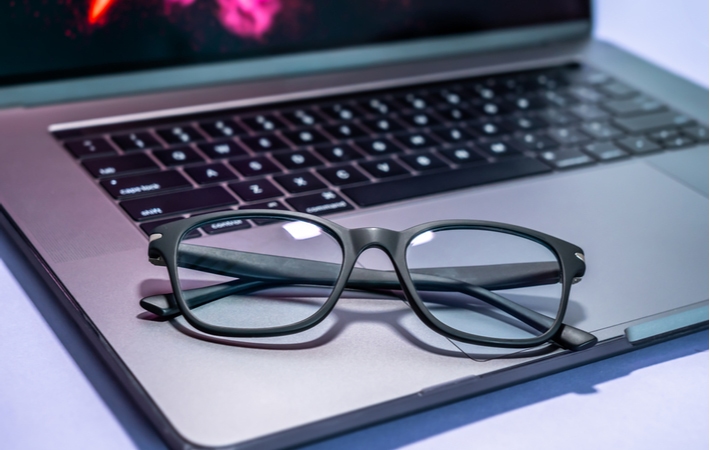People use computers and digital screens extensively for work, school, and other activities. Your eyes may hurt, itch or burn when looking at screens, but why does this happen? Is it an underlying issue, or are you straining your eyes?
Continue reading to learn more about why your eyes hurt when looking at digital screens.
Why Do Your Eyes Hurt When Looking at Screens?
Have you ever had a headache, sore neck, or burning eyes after working on your computer or reading on your phone? These symptoms are uncomfortable, making it difficult to enjoy the rest of your day.
With many people using digital screens to work, relax, and keep up with everyday life, you’ll likely experience tired eyes at least once. When you have sore eyes, the cause of this irritation is known as digital eye strain.
What is Digital Eye Strain?
Digital eye strain is a condition causing discomfort and vision problems when you use digital devices for long periods. When the average Canadian spends up to 11 hours a day looking at screens, this condition is common for many people.
It can be harder to focus on work or other tasks when experiencing digital eye strain. This condition isn’t a significant health risk, but it can lower your quality of life.
Digital Eye Strain Symptoms
If you suffer from digital eye strain, you may experience several symptoms, including:
- Sore, tired, burning, or itchy eyes
- Watery eyes
- Dry eyes
- Blurred vision
- Double vision
- Headaches
- Sore neck, shoulders, or back
- Light sensitivity
- Difficulty concentrating
- Difficulty keeping your eyes open
You likely won’t experience all of these symptoms, but many are common. If you have dry and irritated eyes after using your computer or another digital device, what causes this to happen?
What Causes Digital Eye Strain?
Some of the common causes of digital eye strain include:
- Blinking less when using digital devices
- Viewing screens from poor distances & angles
- Using devices with glare or reflection
- Using devices with poor contrast between text & background
While computer use is typically why your eyes feel strained, the cause of your irritation is more complicated. Your symptoms develop not because of screens themselves but because of how you use your devices.
Your eyes constantly focus and refocus when using a computer or another digital device. They move back and forth as you read, shift gaze between your screen and other documents, and adjust to changing images on your screen.
Besides the fatigue your eyes sustain from these actions, computer screens may have poor contrast, flicker, or glare. Additionally, people tend to blink up to 50% less when using digital devices, leading to dry eyes.
For some people, digital eye strain symptoms may be a sign of an underlying issue. Certain eye conditions, like refractive errors, can make computer use more difficult. Having a comprehensive eye exam can help your optometrist determine the cause of your symptoms, and they can then recommend an effective treatment plan.

Digital Eye Strain Management
Unfortunately, there isn’t a cure for digital eye strain, but you can help prevent or reduce its effects. Your optometrist can recommend several ways to help manage this condition. Whether by changing your screen habits or specialized eyewear, you can protect yourself from irritated eyes.
Blue Light Glasses
Screens emit blue light that can disrupt your circadian rhythm, making it harder to sleep and leaving you with tired eyes. Blue light glasses can help block this light when working on your computer, protecting your eyes.
The 20/20/20 Rule
Many people stare at their screens for extended periods without rest, leading to strained eyes. An effective way to prevent this irritation is to utilize the 20/20/20 rule.
The process is simple—take a 20-second break every 20 minutes to focus your eyes on something at least 20 feet away. Taking these 20-second breaks throughout the day can help reduce digital eye strain.
Visual Ergonomics
Many computer habits can lead to digital eye strain. You may sit too close to the screen, or the incoming light may reflect off your screen. Your optometrist can give you recommendations on how to improve your workstation and screen habits.
Some adjustments you can make include:
- Raising the contrast on your screen
- Making your text larger
- Changing the brightness of your screen to match your surroundings
- Positioning your screen to be around an arm’s length away
- Adjusting your room’s lighting to avoid glare
Neurolens®
Many people who have strained eyes also have an eye misalignment. If your optometrist identifies any misalignment, they can recommend Neurolens®.
Neurolens® can help address misalignment, providing relief from digital eye strain symptoms. These glasses feature a contoured prism to correct misalignment at all distances.
Conducted research found that Neurolens® can significantly improve digital eye strain symptoms. 83% of wearers felt improvement in their headaches, and 78% of wearers had a reduction in neck pain. Around 84% of wearers improved eye discomfort when using the computer.
Don’t Suffer From Strained Eyes
While screen time is unavoidable, you can protect your eyes from irritation and discomfort. Whether with visual ergonomics or Neurolens®, your optometrist can help you manage your digital eye strain symptoms.
If you have symptoms of digital eye strain, contact your optometrist today.




